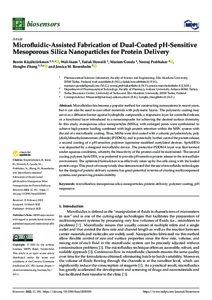| dc.contributor.author | Inam Wali | |
| dc.contributor.author | Küçüktürkmen Berrin | |
| dc.contributor.author | Zhang Hongbo | |
| dc.contributor.author | Prabhakar Neeraj | |
| dc.contributor.author | Howaili Fadak | |
| dc.contributor.author | Gouda Mariam | |
| dc.contributor.author | Rosenholm Jessica M. | |
| dc.date.accessioned | 2022-10-28T14:35:45Z | |
| dc.date.available | 2022-10-28T14:35:45Z | |
| dc.identifier.uri | https://www.utupub.fi/handle/10024/172266 | |
| dc.description.abstract | Microfluidics has become a popular method for constructing nanosystems in recent years, but it can also be used to coat other materials with polymeric layers. The polymeric coating may serve as a diffusion barrier against hydrophilic compounds, a responsive layer for controlled release, or a functional layer introduced to a nanocomposite for achieving the desired surface chemistry. In this study, mesoporous silica nanoparticles (MSNs) with enlarged pores were synthesized to achieve high protein loading combined with high protein retention within the MSN system with the aid of a microfluidic coating. Thus, MSNs were first coated with a cationic polyelectrolyte, poly (diallyldimethylammonium chloride) (PDDMA), and to potentially further control the protein release, a second coating of a pH-sensitive polymer (spermine-modified acetylated dextran, SpAcDEX) was deposited by a designed microfluidic device. The protective PDDMA layer was first formed under aqueous conditions, whereby the bioactivity of the protein could be maintained. The second coating polymer, SpAcDEX, was preferred to provide pH-sensitive protein release in the intracellular environment. The optimized formulation was effectively taken up by the cells along with the loaded protein cargo. This proof-of-concept study thus demonstrated that the use of microfluidic technologies for the design of protein delivery systems has great potential in terms of creating multicomponent systems and preserving protein stability. | |
| dc.language.iso | en | |
| dc.publisher | MDPI | |
| dc.title | Microfluidic-Assisted Fabrication of Dual-Coated pH-Sensitive Mesoporous Silica Nanoparticles for Protein Delivery | |
| dc.identifier.url | https://www.mdpi.com/2079-6374/12/3/181 | |
| dc.identifier.urn | URN:NBN:fi-fe2022081155065 | |
| dc.relation.volume | 12 | |
| dc.contributor.organization | fi=biotiedekeskuksen yhteiset|en=Biotiedekeskuksen yhteiset| | |
| dc.contributor.organization-code | 2609200 | |
| dc.converis.publication-id | 175274836 | |
| dc.converis.url | https://research.utu.fi/converis/portal/Publication/175274836 | |
| dc.identifier.eissn | 2079-6374 | |
| dc.identifier.jour-issn | 2079-6374 | |
| dc.okm.affiliatedauthor | Zhang, Hongbo | |
| dc.okm.discipline | 317 Pharmacy | en_GB |
| dc.okm.discipline | 317 Farmasia | fi_FI |
| dc.okm.discipline | 318 Medical biotechnology | en_GB |
| dc.okm.discipline | 318 Lääketieteen bioteknologia | fi_FI |
| dc.okm.internationalcopublication | international co-publication | |
| dc.okm.internationality | International publication | |
| dc.okm.type | Journal article | |
| dc.publisher.country | Switzerland | en_GB |
| dc.publisher.country | Sveitsi | fi_FI |
| dc.publisher.country-code | CH | |
| dc.relation.articlenumber | 181 | |
| dc.relation.doi | 10.3390/bios12030181 | |
| dc.relation.ispartofjournal | Biosensors | |
| dc.relation.issue | 3 | |
| dc.year.issued | 2022 | |
